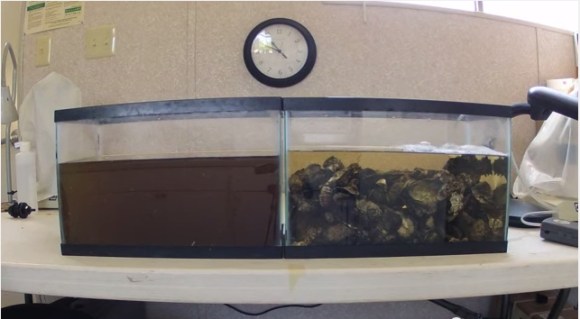
You may be familiar with oysters as the delicious seafood best eaten raw (or as ice cream) and served in months ending in “r,” but did you also know the little guys have impressive filtering skills that can clean even the dirtiest water?
Eating its fill of plankton and other particles floating around, a fully grown oyster can filter more than 50 gallons (189 liters) of seawater in one day. After seeing a few videos demonstrating this cleaning ability, some Japanese netizens started to question just how appetizing this made the once delicious-looking oyster.
In the video posted by a U.S. environmental advocacy group, two tanks of dirty water are placed right next to each other with the only difference being that one is filled with oysters. About two hours pass in the short time-lapse video and the oyster-filled tank looks practically clear by the end.
As you can see it dramatically displayed in the video above, the humble oyster does a pretty amazing job of keeping bodies of water clean (and arguably better than NASA-designed water bottles). And for most of history, natural oyster beds have been keeping water clean all over the world. Check out another video showing a group of oysters at work.
Unfortunately over-harvesting, disease and pollution have taken their toll on oysters all over the world, leaving nature’s water filter at less than one percent of its historical population. And after seeing these videos, Japanese netizens came to realize just how important the oyster is to marine ecosystems. But after pondering the oyster’s role in keeping our oceans clean, viewers began to worry about a different pressing issue: isn’t it a little disgusting to be eating something that has been sucking in all that junk from the ocean?
▼Who cares if oysters have been filter waste from the ocean if you can grill them wrapped in delicious bacon?

A lot of commenters pointed out that while this was great news for cleaning up our oceans, this was bad news for any oyster lover who would be turned off the shellfish after seeing videos of them filtering water so effectively. Some concerned oyster lovers said they would be making sure from now on exactly where their next round of delicious oysters come from and whether or not they were living in polluted waters. And a few commented that eating oysters was no more disgusting then eating liver as it is an organ in an animal’s body that also acts as a filter.
At the end of the day, with the dismal state of some of the world’s water, such as Tokyo Bay’s unfortunate tendency to turn red in the summer months, hopefully our friend the oyster can help us in getting that natural balance back. In the mean time, double-check where your oyster is coming from and say thanks to the hardworking shellfish before you douse him in lemon and sherry vinegar sauce.
Feature Image: YouTube (Florida Oceanographic)
Source: Karapia, National Oceanic Atmospheric Administration

 Love oysters? You can now wear them in style — as a shoulder bag!
Love oysters? You can now wear them in style — as a shoulder bag! Can you guess what type of seafood pugs look like?
Can you guess what type of seafood pugs look like? The world’s biggest Muji store opened in Hiroshima, and we went to check it out!
The world’s biggest Muji store opened in Hiroshima, and we went to check it out! Tokyo restaurant’s amazing all-you-can-eat oyster deal works out to less than three bucks an hour
Tokyo restaurant’s amazing all-you-can-eat oyster deal works out to less than three bucks an hour Japanese-style Rilakkuma teahouse opens in one of the most beautiful places in Japan
Japanese-style Rilakkuma teahouse opens in one of the most beautiful places in Japan McDonald’s new Happy Meals offer up cute and practical Sanrio lifestyle goods
McDonald’s new Happy Meals offer up cute and practical Sanrio lifestyle goods Studio Ghibli glasses cases let anime characters keep an eye on your spectacles
Studio Ghibli glasses cases let anime characters keep an eye on your spectacles All-you-can-drink Starbucks and amazing views part of Tokyo’s new 170 meter-high sky lounge
All-you-can-drink Starbucks and amazing views part of Tokyo’s new 170 meter-high sky lounge Super Nintendo World expansion gets delayed for several months at Universal Studios Japan
Super Nintendo World expansion gets delayed for several months at Universal Studios Japan Beautiful Sailor Moon manhole cover coasters being given out for free by Tokyo tourist center
Beautiful Sailor Moon manhole cover coasters being given out for free by Tokyo tourist center More foreign tourists than ever before in history visited Japan last month
More foreign tourists than ever before in history visited Japan last month Creative Japanese office installs awesome full-size vending machine made out of cardboard【Video】
Creative Japanese office installs awesome full-size vending machine made out of cardboard【Video】 Disney princesses get official manga makeovers for Manga Princess Cafe opening in Tokyo
Disney princesses get official manga makeovers for Manga Princess Cafe opening in Tokyo Starbucks reopens at Shibuya Scramble Crossing with new look and design concept
Starbucks reopens at Shibuya Scramble Crossing with new look and design concept Ramen made by a sauna shop opens its doors in Tokyo
Ramen made by a sauna shop opens its doors in Tokyo Beautiful new Final Fantasy T-shirt collection on the way from Uniqlo【Photos】
Beautiful new Final Fantasy T-shirt collection on the way from Uniqlo【Photos】 Is the new Shinkansen Train Desk ticket worth it?
Is the new Shinkansen Train Desk ticket worth it? Foreign English teachers in Japan pick their favorite Japanese-language phrases【Survey】
Foreign English teachers in Japan pick their favorite Japanese-language phrases【Survey】 Japanese convenience store packs a whole bento into an onigiri rice ball
Japanese convenience store packs a whole bento into an onigiri rice ball We try out “Chan Ramen”, an underground type of ramen popular in the ramen community
We try out “Chan Ramen”, an underground type of ramen popular in the ramen community Studio Ghibli releases Kiki’s Delivery Service chocolate cake pouches in Japan
Studio Ghibli releases Kiki’s Delivery Service chocolate cake pouches in Japan Japan’s bone-breaking and record-breaking roller coaster is permanently shutting down
Japan’s bone-breaking and record-breaking roller coaster is permanently shutting down New definition of “Japanese whiskey” goes into effect to prevent fakes from fooling overseas buyers
New definition of “Japanese whiskey” goes into effect to prevent fakes from fooling overseas buyers Our Japanese reporter visits Costco in the U.S., finds super American and very Japanese things
Our Japanese reporter visits Costco in the U.S., finds super American and very Japanese things Studio Ghibli unveils Mother’s Day gift set that captures the love in My Neighbour Totoro
Studio Ghibli unveils Mother’s Day gift set that captures the love in My Neighbour Totoro Foreign passenger shoves conductor on one of the last full runs for Japan’s Thunderbird train
Foreign passenger shoves conductor on one of the last full runs for Japan’s Thunderbird train Domino’s Japan now sells…pizza ears?
Domino’s Japan now sells…pizza ears? New Japanese KitKat flavour stars Sanrio characters, including Hello Kitty
New Japanese KitKat flavour stars Sanrio characters, including Hello Kitty Kyoto creates new for-tourist buses to address overtourism with higher prices, faster rides
Kyoto creates new for-tourist buses to address overtourism with higher prices, faster rides Sales of Japan’s most convenient train ticket/shopping payment cards suspended indefinitely
Sales of Japan’s most convenient train ticket/shopping payment cards suspended indefinitely Sold-out Studio Ghibli desktop humidifiers are back so Totoro can help you through the dry season
Sold-out Studio Ghibli desktop humidifiers are back so Totoro can help you through the dry season Japanese government to make first change to romanization spelling rules since the 1950s
Japanese government to make first change to romanization spelling rules since the 1950s Ghibli founders Toshio Suzuki and Hayao Miyazaki contribute to Japanese whisky Totoro label design
Ghibli founders Toshio Suzuki and Hayao Miyazaki contribute to Japanese whisky Totoro label design Doraemon found buried at sea as scene from 1993 anime becomes real life【Photos】
Doraemon found buried at sea as scene from 1993 anime becomes real life【Photos】 Tokyo’s most famous Starbucks is closed
Tokyo’s most famous Starbucks is closed One Piece characters’ nationalities revealed, but fans have mixed opinions
One Piece characters’ nationalities revealed, but fans have mixed opinions We asked a Uniqlo employee what four things we should buy and their suggestions didn’t disappoint
We asked a Uniqlo employee what four things we should buy and their suggestions didn’t disappoint Princesses, fruits, and blacksmiths: Study reveals the 30 most unusual family names in Japan
Princesses, fruits, and blacksmiths: Study reveals the 30 most unusual family names in Japan We buy oysters from a Japanese vending machine
We buy oysters from a Japanese vending machine Japan’s secret garbage problem–and what you can do to help
Japan’s secret garbage problem–and what you can do to help Fried Oyster Ice Cream: the taste of the sea in a Japanese soft serve dessert【Taste Test】
Fried Oyster Ice Cream: the taste of the sea in a Japanese soft serve dessert【Taste Test】 Japanese restaurant lets generous customers pay for extra meals, needy customers eat for free
Japanese restaurant lets generous customers pay for extra meals, needy customers eat for free You can buy this huge sunfish at a supermarket in Japan
You can buy this huge sunfish at a supermarket in Japan Top 10 food disasters prepared by Japanese wives who have extraordinary talent in the kitchen
Top 10 food disasters prepared by Japanese wives who have extraordinary talent in the kitchen Make all your friends jelly with these umbrellas inspired by jellyfish【Pics】
Make all your friends jelly with these umbrellas inspired by jellyfish【Pics】 A foray into canned food with Jasmine Rice & Thai Curry in a can from Japan’s Inaba Foods
A foray into canned food with Jasmine Rice & Thai Curry in a can from Japan’s Inaba Foods Japanese survey reveals the top 10 most popular ice creams in Japan
Japanese survey reveals the top 10 most popular ice creams in Japan AQTAS: the deep fryer that not only is safe to add water to, but uses it for better frying
AQTAS: the deep fryer that not only is safe to add water to, but uses it for better frying What’s the best way to eat Japanese cream stew and rice, “together” or “separate?”【Survey】
What’s the best way to eat Japanese cream stew and rice, “together” or “separate?”【Survey】 100 things to do in Japan in 100 seconds 【Video】
100 things to do in Japan in 100 seconds 【Video】 Japan now has “Gyoza for Athletes”, thanks to figure skating Olympian Yuzuru Hanyu 【Taste test】
Japan now has “Gyoza for Athletes”, thanks to figure skating Olympian Yuzuru Hanyu 【Taste test】 This rare autumn vegetable is the perfect addition to your stir-fry or salad【SoraKitchen】
This rare autumn vegetable is the perfect addition to your stir-fry or salad【SoraKitchen】 The LifeStraw can make all kinds of water drinkable, but does it work on urine? 【Video】
The LifeStraw can make all kinds of water drinkable, but does it work on urine? 【Video】
Leave a Reply